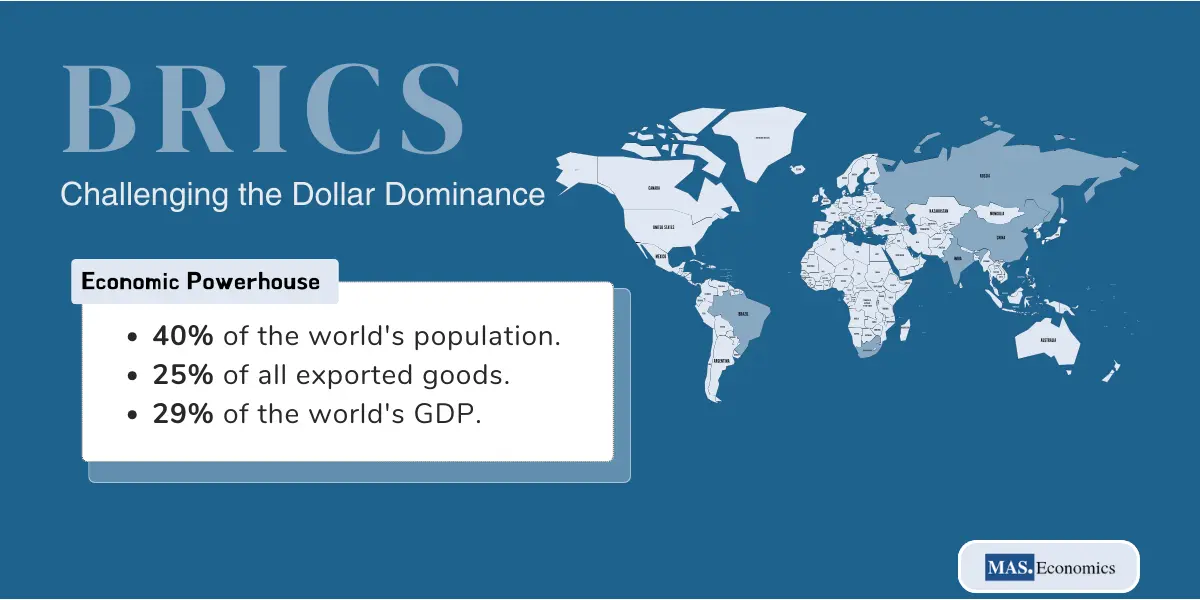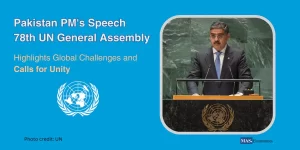Welcome to MASEconomics, your trusted source for insights into the complex world of economics. The global financial stage is undergoing a profound transformation as emerging economies challenge the age-old dominance of the United States and its Western allies. The BRICS alliance, comprising Brazil, Russia, India, China, and South Africa, is at the heart of this seismic shift. In this article, we will delve into the rise of BRICS, its motivations, and the potential consequences it could have for the world economy.
BRICS – A Growing Force
The BRICS alliance didn’t materialize overnight. It began as an economic concept proposed by Jim O’Neill, an economist at Goldman Sachs, who observed the remarkable growth rates in Brazil, Russia, India, and China. These countries, dubbed the “rising stars” at the time, were experiencing explosive economic growth.
However, it wasn’t until 2009, in the wake of the global financial crisis, that the first official BRICS summit took place in Russia. South Africa joined the group in 2010, completing our current alliance. These nations came together because they started questioning the reliability and trustworthiness of the U.S.-led global financial system, especially after the 2008 recession.
Economic Powerhouse
BRICS has evolved into a formidable economic powerhouse, representing more than 40% of the world’s population and a quarter of the global economy. As of the end of 2023, they are estimated to control a staggering 25% of all exported goods, equivalent to approximately 29% of the world’s GDP. This impressive economic might is poised to reshape the world order.
Challenging the Dollar Dominance
To comprehend why BRICS challenges the dollar, we must revisit history. In 1944, the Bretton Woods agreement was signed by 44 countries, designating the U.S. dollar as the world’s reserve currency. The U.S. was the default choice for this role, being the primary standing superpower post-World War II.
Shortly after 1945, a secret wartime meeting between President Franklin Roosevelt and the King of Saudi Arabia established the petrodollar system. In exchange for U.S. protection, Saudi Arabia granted the U.S. exclusive rights to develop oil in its territory. This cemented the U.S. dollar’s importance in the global economy, creating a link between energy and the dollar.
One of the key advantages of being a world reserve currency is the ability to print money without causing inflation at home. However, this can affect the global economy significantly. When the U.S. prints money to solve its problems, it can create inflation worldwide, impacting other countries and their economies.
This phenomenon has led to concerns about the U.S.’s role as the world’s economic powerhouse and prompted countries like those in BRICS to seek alternatives.
The BRICS Alternative
Creation of NDB
One of the most significant moves by BRICS in challenging the U.S.-dominated financial system is the establishment of the New Development Bank (NDB). This institution, founded in 2014, serves as a powerful alternative to traditional lending organizations like the International Monetary Fund (IMF) and the World Bank. What sets the NDB apart is its focus on financing development and infrastructure projects, particularly in emerging economies.
Since its inception, the NDB has approved over $30 billion in loans for various initiatives. These loans aren’t just about capital; they represent a shift in the balance of financial power. Emerging economies that have long relied on Western-dominated institutions can now turn to the NDB for financial support tailored to their needs.
However, it’s important to note that while the NDB represents a bold step towards financial autonomy, many of its transactions are still conducted in U.S. dollars. This reflects the continued influence and dominance of the dollar in global finance. BRICS recognizes that reducing dependence on the dollar is essential for achieving their goal of reshaping the financial landscape.
Dollar Dependence: The Need for a New Currency
BRICS countries are acutely aware of the pitfalls of dollar dependence. While they’ve made significant strides in establishing the NDB, they understand that the true transformation lies in potentially introducing their own currency backed by gold or other tangible assets. Such a move would significantly reduce their reliance on the dollar-dominated financial system.
By backing their currency with gold, BRICS countries aim to create a robust and stable medium of exchange that can withstand the volatility often associated with fiat currencies. This approach aligns with a broader global trend of central banks diversifying their reserves away from the dollar, a move driven by concerns about inflation and economic stability.
BRICS Gold-Backed Currency
The BRICS alliance has set its sights on a potential game-changer: a gold-backed currency. Backed by tangible assets, this currency represents a departure from the traditional fiat currencies that dominate today’s financial systems.
The allure of gold as a stable and reliable store of value cannot be overstated. Unlike fiat currencies, which derive their worth from government declarations, a gold-backed currency’s value is directly linked to the amount of gold held in reserve. This intrinsic stability offers a hedge against the volatility often associated with fiat currencies.
If realized, this currency could pose a significant challenge to the dominance of the U.S. dollar and other fiat currencies, reshaping the global financial order. With comparisons drawn to other reserve currencies like the U.S. dollar and the International Monetary Fund’s Special Drawing Rights, the BRICS gold-backed currency represents a bold step toward a more balanced and stable economic world.
While the ultimate outcome remains uncertain, the very consideration of such a currency emphasizes the BRICS nations’ commitment to enhancing stability and reshaping the global economic order. It’s a pivotal moment in the world of finance that underscores the evolving dynamics of global economics and politics.
The Impact on the U.S. and the World
Effects on Investors
The prospect of a shift away from the U.S. dollar has far-reaching implications for investors and asset markets within the United States. If confidence in the dollar diminishes, investors may reconsider their strategies. One potential outcome is the withdrawal of capital from U.S. markets, as investors seek alternatives perceived as more stable.
This shift could affect the attractiveness of U.S. assets, including stocks, real estate, and other investment vehicles. As the dollar’s role in global finance evolves, investors must adapt to new opportunities and challenges in a changing financial landscape.
Inflation and Middle-Class Concerns
Reduced global demand for dollars carries the risk of higher inflation within the U.S. economy. Historically, the ability of the U.S. government to export its inflation through foreign exchange reserves has helped mitigate inflationary pressures domestically. However, as the world’s need for dollars diminishes, this crucial buffer weakens.
The potential consequence is higher prices for goods and services within the United States, which could disproportionately affect the middle class. Inflation erodes purchasing power, making it more challenging for ordinary citizens to maintain their standard of living. Addressing these concerns will become critical for policymakers facing a changing global financial landscape.
Uncertain Future
The consequences of BRICS challenging the dollar’s dominance are complex and uncertain. While the alliance aims to reshape the global financial landscape, it faces internal challenges due to differing goals among its member countries. Achieving consensus within BRICS remains a formidable task, and the ultimate outcome is uncertain.
What is clear, however, is that we are witnessing a pivotal moment in the world of finance. The rise of BRICS and their efforts to challenge the long-standing supremacy of the U.S. dollar underscore the evolving dynamics of global economics and politics. As we navigate this uncertain future, understanding the forces at play and their potential impacts will be crucial for governments, investors, and individuals alike.
Conclusion
The rise of BRICS and its challenge to the U.S.-dominated financial order represent a momentous shift in global politics, economics, and finance. The future remains uncertain, as BRICS seeks to assert itself and reshape the financial world. Whether this shift will lead to a more balanced and prosperous global economy or bring unforeseen challenges is a question only time will answer. As we live through this historic transformation, we must closely watch how these emerging economies navigate their path to a new world order in finance.
The Road Ahead
BRICS members have different objectives within the alliance. Some advocate for expansion and closer ties to challenge Western dominance, while others prioritize maintaining positive relationships with the United States. Striking a balance among these diverse interests will be a significant challenge for the alliance.
Supporters of BRICS argue that diversifying the global financial system could lead to greater global prosperity, reduce poverty, and promote world peace. However, critics warn that with a clear vision and common purpose, BRICS could become autocratic or retain its relevance.
Stay informed, stay ahead, and continue your learning journey with MASEconomics!




